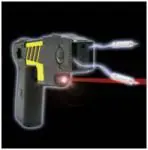source: EINPresswire news
ROCHESTER, NEW YORK, UNITED STATES, November 9, 2017 For more than 10 years, Ohmcraft has manufactured and supplied the high voltage chip resistors utilized in conductive electrical weapons (CEW). The devices, more commonly known as stun guns, have long been leveraged as a mode of protection for law enforcement, as well as for self-defense by the general public.
A stun gun is classified as an electroshock weapon. It is employed by firing two small, projectile-like electrodes that attach themselves to the recipient before delivering a non-lethal electrical pulse to disrupt muscle control, thereby rendering the person temporarily incapacitated. In law enforcement, stun guns are an effective non-lethal alternative for officers who need to subdue potentially dangerous individuals. A review conducted by the Department of Justice in 2011 found that 99.7 percent of people shocked by CEWs suffer no injuries, or only minor injuries.*
Ohmcraft precision surface mount resistors are used by the stun gun’s internal circuit to measure and control the voltage of the electrical pulse being delivered by the electrodes. Because of the size and nature of CEWs, they require small-form factor resistors with an ultra-low voltage coefficient of resistance to precisely control the voltage output. These features are imperative to the safety of the recipient of the shock, as well as the individual using the stun gun.
“Ohmcraft high precision resistors have long been used in electrical weapons for law enforcement, military and personal defense,” said Eric Van Wormer, Vice President of the Ohmcraft division of Micropen Technologies. “Stun guns are most often employed in high-stress scenarios, and their operation is a matter of life and death—for both the carrier and the recipient. Our resistors are critical in ensuring the weapon’s reliable performance in each and every circumstance.”
A study by the Police Executive Research Forum in 2009 revealed that injuries to law enforcement personnel dropped by 76 percent when a stun gun was used**, while the 2011 Department of Justice research reported that injuries to suspects decreased by nearly 60 percent with the use of CEWs.*
* Source: “Police Use of Force, Tasers and Other Less-Lethal Weapons,” U.S. Department of Justice, https://www.ncjrs.gov/pdffiles1/nij/232215.pdf
** Source: “Comparing Safety Outcomes in Police Use-of-Force Cases for Law Enforcement Agencies That Have Deployed Conducted Energy Devices,” Police Executive Research Forum, http://www.policeforum.org
featured image source: peppereyes.com































